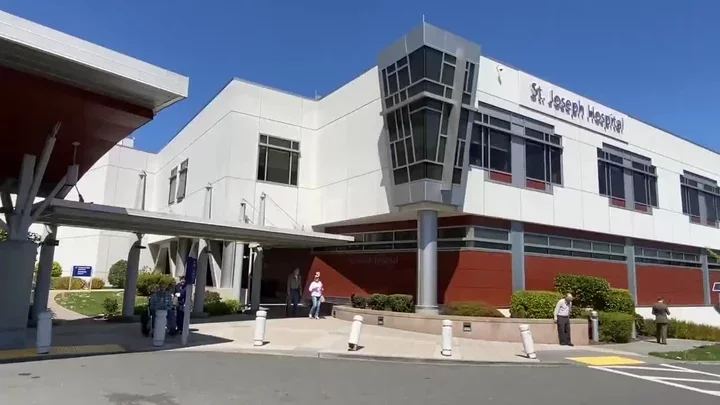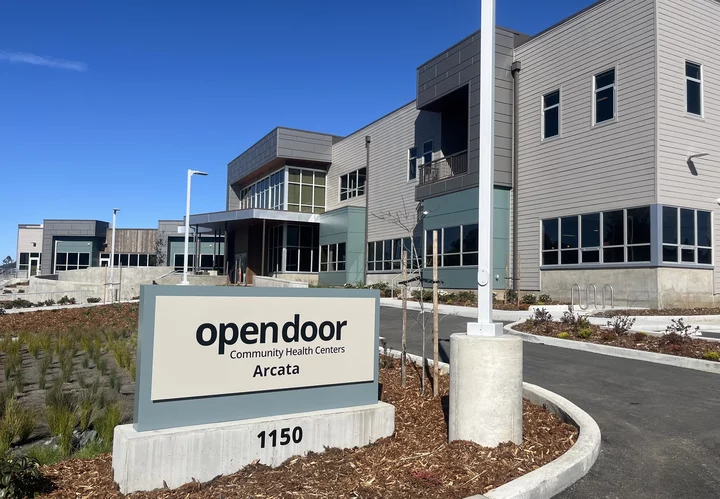Medical professionals at Providence St. Joseph Hospital in Eureka worry that the lapse in telehealth services will force some Medicare patients to delay critical care. | File photo.
###
As the government shutdown stretches into its sixth week, millions of Medicare patients who rely on telehealth services to see their doctors are being forced to either pay out-of-pocket for virtual visits or forgo appointments entirely. While in-person appointments are still available, telehealth services provide a lifeline to elderly or disabled patients who have a difficult time traveling, especially those who live in rural or underserved areas like Humboldt County.
In a recent interview with the Outpost, Dr. John Aryanpur, a neurosurgeon at St. Joseph Hospital and Chief Medical Officer for NorCal Providence Medical Group & Clinical Network, estimated that telehealth visits accounted for “between 10 and 18 percent” of outpatient visits before the government shut down on Oct. 1.
“These actions, unfortunately, have impacted our patients in Humboldt and all across northern California,” Dr. Aryanpur said. “We’ve had a number of folks who have canceled appointments or deferred care that we feel is time sensitive. Many of our clinicians are feeling very stressed because they have folks who they need to provide care to who are not coming in or who are deciding to defer care because of these actions.”
Medicare, which provides federal health insurance for people over 65, stopped paying for telehealth services and in-home hospital care programs when the government shut down on Oct. 1. A Senate vote on Sunday cleared the way for a spending deal to end the shutdown this week. If the deal moves ahead, it is still unlikely that the government would reopen before Wednesday, according to The New York Times.
However, even if the government reopens in the coming days, that doesn’t mean telehealth services and in-home hospital care programs will automatically resume for Medicare patients. Those programs lapsed on Sept. 30, and to receive federal funding, Congress must approve the Hospital Inpatient Services Modernization Act, which would extend telehealth services through the end of 2030.
Telehealth services were meant to be a temporary alternative to in-person visits during the COVID-19 pandemic, but have increased in popularity over the years, especially among the elderly and people living in rural communities.
A report from the Brown University School of Public Health found California had the highest rate of telehealth usage, with 26 percent of Medicare beneficiaries using remote health care services at least one time during the first half of 2025.
“In Humboldt County, we have a fair number of folks with chronic medical conditions who live in very inaccessible areas that are far from our cities, and the ability to provide them with medical care via telehealth has — in my opinion and in some cases — been life-saving,” Dr. Aryanpur said. “It’s very difficult to not have that ability since October 1. It seriously impacts folks across the spectrum.”
Dr. James Goldberg, St. Joseph and Redwood Memorial Hospital’s Chief Medical Officer, added that telehealth services allow patients to seek care locally, rather than travelling out of the area.
“On the hospital side, it’s actually been a way for us to bring specialty care to our inpatients so that we don’t need to transfer them out of the area,” Dr. Goldberg said. “They could stay in Humboldt in our hospitals with their families and not have to worry about the travel. … When you have a rural community like this, it can be difficult to recruit specialists, too. [Telehealth] really opens that door to allow [us] to provide that necessary specialist care.”
There are some exceptions for rural residents. Guidance from the Centers for Medicare & Medicaid Services (CMS) notes that Medicare beneficiaries “will generally need to be in a medical facility and in a rural area to receive Medicare telehealth services.” That means people who are seeking telehealth services still have to travel to a brick-and-mortar clinic to get remote health care services.
Approximately 20 percent of Open Door’s patients use telehealth services. | File photo.
Tory Starr, CEO of Open Door Community Health Centers, said Open Door’s clinics have leaned on this exemption to provide Medicare patients with the care that they need. However, whether or not Open Door will be reimbursed by Medicare for its services remains to be seen.
“As a cautionary approach, we have been having folks come into the clinic and see some of our remote providers that way,” Starr told the Outpost, noting that Open Door can provide transportation to its facilities for some patients. “Therefore, they’re considered inside the four walls of the health center, and that qualifies under Medicare. … If somebody really needs to communicate with their provider and they’re not able to get in [to the clinic], we are still serving folks, and we will work through the reimbursement issues if they arise later.”
Open Door has ingrained telehealth into its services since the pandemic, Starr said, noting that remote appointments account for about 20 percent of all visits.
“If somebody literally can’t get in, we will still do a telehealth visit with them, and we’ll see what happens with our payment in the long run,” Starr said. “We believe that we do qualify under the rural exemption, so we’re being cautious, but if people really do need a virtual visit, we will do that. … We’ve tried to make sure that people aren’t being negatively impacted by this change … but it could definitely be negatively impacting Open Door’s finances.”
“We always put patient care first,” he added. “We certainly have the ability [at] both the state and federal level to advocate for payment, even if it’s retroactive. … It’s just, instead of getting paid for a visit, we may not get paid for that visit.”
Similarly, Dr. Aryanpur said Providence will “still provide telehealth care to those who need it,” and staff will “sort it out later.” Still, some patients are choosing to put off appointments out of fear that they won’t be reimbursed.
“However, there are some Medicare patients who are uncomfortable with that, because, as it stands now, they might have to pay out of pocket,” he said. “For example, last week, I was made aware of a patient who needed to see a specialist for an urgent condition. The initial visit was telehealth in order to set up a surgery, but the patient decided to decline the telehealth visit and delay care until this issue is resolved. I’m hoping that doesn’t result in a poor outcome, but I’m quite worried.”
Providence Humboldt County Communications Manager Shannon Garcia provided the following additional statement:
Before the U.S. federal government shut down on October 1, Providence proactively prepared for immediate changes to our health care operations and reimbursement policies for certain services. While we expect essential programs like Medicare and Medicaid to continue to process payments in the immediate future, disruptions to federal oversight and the expiration of health waivers have impacted care delivery across the Providence family of organizations.
Most notably, telehealth waivers first adopted during the pandemic expired without Congressional action, jeopardizing care for many Medicare patients who often relied on these virtual services for timely treatment. In response, Providence proactively prepared for telehealth services to return to pre-pandemic guidelines, which limited the type of telehealth services that qualify for reimbursement including restrictions for audio-only visits, types of service and sites of service. Due to this change, some Medicare patients are being asked to come in for appointments that were originally scheduled as telehealth to ensure their care is covered.
In addition, the Acute Hospital at Home (HaH) waiver lapsed, requiring all patients who were receiving inpatient-level care at home to be transferred to a hospital or discharged to another appropriate setting. Like other health systems, Providence actively coordinated transitions for affected patients to minimize disruptions and ensure safe, high-quality care.
Despite these challenges, Providence remains committed to reducing impacts to our patients and ensuring continuity of care for the communities we serve. We continue to advocate for the restoration of essential waivers that support flexible and accessible care delivery. Most importantly, Providence’s hospitals, outpatient clinics and medical offices remain open and operational to provide high-quality, compassionate care to our communities, ensuring that every patient receives the essential care they need.


CLICK TO MANAGE